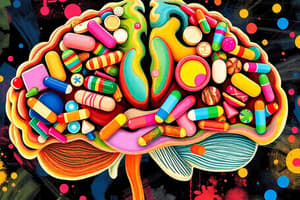Podcast
Questions and Answers
Which neurotransmitter is primarily associated with mood regulation?
Which neurotransmitter is primarily associated with mood regulation?
- Adrenaline
- Noradrenaline
- Serotonin (correct)
- Dopamine
What is the main function of GABA as a neurotransmitter?
What is the main function of GABA as a neurotransmitter?
- Induces pleasure
- Enhances memory
- Calms neural activity (correct)
- Promotes learning
Among the following options, which one is categorized as a growth factor that acts slower than traditional neurotransmitters?
Among the following options, which one is categorized as a growth factor that acts slower than traditional neurotransmitters?
- Noradrenaline
- BDNF (correct)
- Dopamine
- Glutamate
Which neurotransmitter is primarily involved in the fight or flight response?
Which neurotransmitter is primarily involved in the fight or flight response?
Which neurotransmitter is incorrectly identified as a neurotransmitter?
Which neurotransmitter is incorrectly identified as a neurotransmitter?
What was the suspected cause of the patient's deep coma and paralysis?
What was the suspected cause of the patient's deep coma and paralysis?
How does tetrodotoxin (TTX) affect neuronal function?
How does tetrodotoxin (TTX) affect neuronal function?
What is the significance of the IC50 value for a substance like TTX?
What is the significance of the IC50 value for a substance like TTX?
Which fish was identified as containing tetrodotoxin?
Which fish was identified as containing tetrodotoxin?
What is the primary action of picrotoxin on GABAA receptors?
What is the primary action of picrotoxin on GABAA receptors?
Which neurotransmitter does d-tubocurarine antagonize at the neuromuscular junction?
Which neurotransmitter does d-tubocurarine antagonize at the neuromuscular junction?
What was the historical use of picrotoxin in relation to beer?
What was the historical use of picrotoxin in relation to beer?
What is a common application of TTX-like molecules in medicine?
What is a common application of TTX-like molecules in medicine?
What type of treatment was administered to the patient who consumed pufferfish?
What type of treatment was administered to the patient who consumed pufferfish?
What does neuropharmacology primarily study?
What does neuropharmacology primarily study?
What happens to action potentials when TTX is present?
What happens to action potentials when TTX is present?
What symptoms did the 52-year-old fisherman exhibit after consuming certain fish organs?
What symptoms did the 52-year-old fisherman exhibit after consuming certain fish organs?
What immediate action was taken after identifying the fish the patient consumed?
What immediate action was taken after identifying the fish the patient consumed?
How did picrotoxin affect fish when used in fishing practices?
How did picrotoxin affect fish when used in fishing practices?
Which of the following is NOT considered a sub-discipline of pharmacology?
Which of the following is NOT considered a sub-discipline of pharmacology?
What improvement was first noted in the patient after receiving neostigmine?
What improvement was first noted in the patient after receiving neostigmine?
What type of studies does in vivo neuropharmacology involve?
What type of studies does in vivo neuropharmacology involve?
What is one characteristic of in vitro neuropharmacology?
What is one characteristic of in vitro neuropharmacology?
What kind of plant is picrotoxin derived from?
What kind of plant is picrotoxin derived from?
What clinical state did the patient develop after consuming fish liver and gonads?
What clinical state did the patient develop after consuming fish liver and gonads?
Which statement correctly reflects the evolution of pharmacology over time?
Which statement correctly reflects the evolution of pharmacology over time?
What distinguishes psychopharmacology from neuropharmacology?
What distinguishes psychopharmacology from neuropharmacology?
Why is molar concentration not used in in vivo neuropharmacology?
Why is molar concentration not used in in vivo neuropharmacology?
What is the term used for the study of drug effects on all aspects of the nervous system?
What is the term used for the study of drug effects on all aspects of the nervous system?
What is the primary mechanism by which Novichok poisoning leads to muscle spasms?
What is the primary mechanism by which Novichok poisoning leads to muscle spasms?
What effect does neostigmine have when used with poison in an animal model?
What effect does neostigmine have when used with poison in an animal model?
In the study using eserine, what was the main purpose of this compound?
In the study using eserine, what was the main purpose of this compound?
What is a likely consequence of inhibiting the diaphragm as compared to inhibiting the limbs?
What is a likely consequence of inhibiting the diaphragm as compared to inhibiting the limbs?
Which of the following statements is true regarding neurotransmitter criteria?
Which of the following statements is true regarding neurotransmitter criteria?
What is the expected outcome of using a potent inhibitor like eserine in muscle tests?
What is the expected outcome of using a potent inhibitor like eserine in muscle tests?
What is a major characteristic of Novichok nerve agents?
What is a major characteristic of Novichok nerve agents?
What is a key difference in how the brain is affected compared to the limbs during poisoning?
What is a key difference in how the brain is affected compared to the limbs during poisoning?
Which mechanism is primarily responsible for terminating the action of neurotransmitters?
Which mechanism is primarily responsible for terminating the action of neurotransmitters?
What property must a neurotransmitter possess for it to be considered functional?
What property must a neurotransmitter possess for it to be considered functional?
What neurotransmitter is associated with fast excitation at the neuromuscular junction?
What neurotransmitter is associated with fast excitation at the neuromuscular junction?
What type of neurotransmitter receptor is associated with GABA?
What type of neurotransmitter receptor is associated with GABA?
Why is glutamate considered a critical neurotransmitter in the brain?
Why is glutamate considered a critical neurotransmitter in the brain?
Which neurotransmitter is NOT classified as an amino acid?
Which neurotransmitter is NOT classified as an amino acid?
What mechanism terminates the action of glutamate in central synapses?
What mechanism terminates the action of glutamate in central synapses?
Which neurotransmitter receptor type is primarily associated with slow synaptic responses?
Which neurotransmitter receptor type is primarily associated with slow synaptic responses?
Which neurotransmitter has both excitatory and inhibitory effects depending on its receptor type?
Which neurotransmitter has both excitatory and inhibitory effects depending on its receptor type?
What is the action of TTX in the context of neurotransmission?
What is the action of TTX in the context of neurotransmission?
Flashcards
Neuropharmacology
Neuropharmacology
The study of how drugs affect the nervous system, focusing on their impact on sensory perception, motor function, mood, cognition, and other nervous system activities.
Psychopharmacology
Psychopharmacology
A branch of neuropharmacology that examines the effects of drugs on psychological aspects like emotions and thoughts.
Neuropsychopharmacology
Neuropsychopharmacology
The study of the wide-ranging effects of drugs on the nervous system, encompassing both psychological and physiological impacts.
Medical neuropharmacology
Medical neuropharmacology
Signup and view all the flashcards
In vitro neuropharmacology
In vitro neuropharmacology
Signup and view all the flashcards
In vivo neuropharmacology
In vivo neuropharmacology
Signup and view all the flashcards
Dose-response relationship
Dose-response relationship
Signup and view all the flashcards
Pharmacology
Pharmacology
Signup and view all the flashcards
Compound/Chemical/Agent
Compound/Chemical/Agent
Signup and view all the flashcards
Non-competitive antagonist
Non-competitive antagonist
Signup and view all the flashcards
GABAĄ receptor
GABAĄ receptor
Signup and view all the flashcards
Tetrodotoxin
Tetrodotoxin
Signup and view all the flashcards
Cholinesterase inhibitor
Cholinesterase inhibitor
Signup and view all the flashcards
Neostigmine
Neostigmine
Signup and view all the flashcards
Complete paralysis
Complete paralysis
Signup and view all the flashcards
Bradypnea
Bradypnea
Signup and view all the flashcards
Tetrodotoxin (TTX)
Tetrodotoxin (TTX)
Signup and view all the flashcards
Complete Muscle Paralysis
Complete Muscle Paralysis
Signup and view all the flashcards
IC50 (Half-maximal Inhibitory Concentration)
IC50 (Half-maximal Inhibitory Concentration)
Signup and view all the flashcards
Voltage Gated Sodium Channel
Voltage Gated Sodium Channel
Signup and view all the flashcards
Acetylcholine
Acetylcholine
Signup and view all the flashcards
d-tubocurarine
d-tubocurarine
Signup and view all the flashcards
Acetylcholine Antagonists
Acetylcholine Antagonists
Signup and view all the flashcards
Neuromuscular Junction
Neuromuscular Junction
Signup and view all the flashcards
What are neurotransmitters?
What are neurotransmitters?
Signup and view all the flashcards
What is Serotonin?
What is Serotonin?
Signup and view all the flashcards
What are neuromodulators?
What are neuromodulators?
Signup and view all the flashcards
What is Acetylcholine ?
What is Acetylcholine ?
Signup and view all the flashcards
What is GABA?
What is GABA?
Signup and view all the flashcards
Neurotransmitter
Neurotransmitter
Signup and view all the flashcards
Neurotransmitter Termination
Neurotransmitter Termination
Signup and view all the flashcards
Neurotransmitter Uptake
Neurotransmitter Uptake
Signup and view all the flashcards
Neurotransmitter Enzymatic Inactivation
Neurotransmitter Enzymatic Inactivation
Signup and view all the flashcards
Neurotransmitter Receptor Binding
Neurotransmitter Receptor Binding
Signup and view all the flashcards
Ionotropic Receptor
Ionotropic Receptor
Signup and view all the flashcards
Metabotropic Receptor
Metabotropic Receptor
Signup and view all the flashcards
G-protein Coupled Receptor
G-protein Coupled Receptor
Signup and view all the flashcards
Glutamate
Glutamate
Signup and view all the flashcards
Novichok Poisons
Novichok Poisons
Signup and view all the flashcards
Acetylcholinesterase
Acetylcholinesterase
Signup and view all the flashcards
In Vitro Experiment
In Vitro Experiment
Signup and view all the flashcards
Leech Test
Leech Test
Signup and view all the flashcards
Kymograph
Kymograph
Signup and view all the flashcards
Asphyxiation
Asphyxiation
Signup and view all the flashcards
Study Notes
Introduction to Neuropharmacology
- Neuropharmacology defines the study of drugs impacting the nervous system, encompassing sensory perception, motor function, mood, cognitive function, and seizure activity.
- Neuropharmacology is part of broader cognitive science, encompassing neurophysiology, neuroanatomy, and neuro-techniques.
- Tools in neuroscience, like pharmacological tools, are essential for understanding organ function and brain function specifically.
- Pharmacology has many sub-disciplines and has been used in lethal situations.
Pharmacology and Advancement
- The progression of pharmacology is depicted, showing evolution from ancient, herbal remedies to modern, synthetic drugs and biopharmaceuticals.
- Key milestones include the advancements in chemistry, synthetic chemistry, and biomedical sciences.
- Historical tools relate to magical potions, herbal remedies, natural products, and synthetic chemistry to modern techniques.
Neuropharmacological Tools
- Pharmacological tools help understand how different organs (e.g., brain) function, providing insight into various physiological behaviors.
- These tools aid in understanding brain processes through sub-disciplines like neuroscience.
Neuropharmacology Definition and Key Concepts
- Neuropharmacology is the study of how drugs affect the nervous system.
- This field examines different aspects like sensory perception, motor function, seizures, and diverse nervous system processes.
Case Study 1: Picrotoxin
- Picrotoxin is a non-competitive antagonist for GABA receptors, inhibiting GABA receptors.
- Derived from fishberry plants, it was traditionally used to poison fish and (incorrectly) to make beer more intoxicating. It's now banned for these uses.
- Historically, picrotoxin served as a research tool for understanding anesthetic mechanisms and in treating barbiturate toxicity.
Case Study 2: Food Poisoning
- The case details food poisoning from Pufferfish consumption and its resulting symptoms which include paralysis, rapid progression to deep coma.
- The poisoning involved tetrodotoxin (TTX), affecting the neurotransmitter systems and blocking the Na+ channels.
Case Study 3: Hunting Poison
- Curare vine alkaloids are used in Amazonian hunting poisons.
- The primary alkaloid, tubocurarine, is an acetylcholine receptor antagonist.
- These poisons block muscle contraction, facilitating hunting.
Neurotransmitter Function
- Neurotransmitters are chemical messengers released by neurons.
- These molecules affect neurons, cells and behaviors in various ways.
- Different neurotransmitters (e.g., Acetylcholine, GABA, Glutamate, Endorphins) exhibit diverse functions and impacts.
Mechanisms
- Action potentials are caused by the use of specific channels or receptors by TTX to illustrate how neurotransmission works.
Methods and Application
- Different experiments and neurotransmitter methods and applications are discussed in the document.
Studying That Suits You
Use AI to generate personalized quizzes and flashcards to suit your learning preferences.




